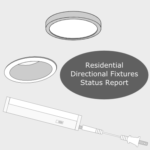
Status on Residential Directional LED Fixtures
Residential LED fixtures have a crazy wide range of efficacy, far surpassing the 40% span we reported on for commercial fixtures in November’s post.
The wide range exists because of the recent history of Energy Star. Despite still being the best program for residential fixtures, it hasn’t changed its efficacy requirements since 2015. Other program updates were made recently, in August 2019, but efficacy requirements remained unchanged.
EnergyStar divides residential lighting fixtures into two groups: directional and non-directional. The directional fixtures category, covered in today’s report, is evaluated by fixture efficacy. (This refers to lumens out of the fixture per watt, just as DLC does for commercial fixtures.)
Below is the current status of the most common types of directional fixtures that are listed on EnergyStar’s certified fixture list. The chart shows the minimum LPW required for EnergyStar Certification along with our recommended minimum for each category.

Our “FDC Recommends” fixture efficacies far exceed the minimums set by EnergyStar. In each case the level represents considered assessment of a reasonable goal, as of January 2020.
Existing EnergyStar minimums, low as they are, are still higher than fluorescent. Fluorescents never were very efficient in these small fixture types, and EnergyStar’s currently certified products in these categories are all LED.
But that doesn’t change the fact that anyone can do at least 58% better than “just going LED” with EnergyStar rated fixtures.
In our next report we’ll cover non-directional residential fixtures. If you haven’t already, subscribe to our mailing list to ensure you don’t miss an article.

